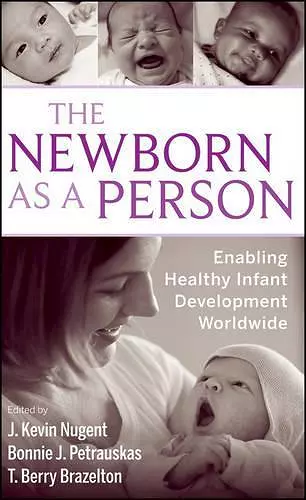The Newborn as a Person
Enabling Healthy Infant Development Worldwide
J Kevin Nugent author T Berry Brazelton author Bonnie Petrauskas author
Format:Hardback
Publisher:John Wiley & Sons Inc
Published:27th Jan '09
Currently unavailable, and unfortunately no date known when it will be back

Advances in the fields of psychology and psychiatry have bolstered the perspective that infants are not the passive recipients of sensory stimulation as it was once thought. Built on T. Berry Brazelton s paradigm-shifting work on the individuality of infants, this book provides relevant information on the necessity for family-centered intervention in the newborn period. Coverage is wide-ranging, authoritative, and practical. This landmark collection includes contributions from T. Berry Brazelton, Tiffany Field, Rachel Keen, and many others. Pediatric professionals will receive practical guidance to support families, immediately beginning in the newborn period.
The Newborn as a Person: Enabling Healthy Infant Development Worldwide is a tribute to these 35 years of clinical and empirical use of the NBAS and attests to its immense impact on the way we conceptualize the infant. Its chapters are short and user friendly; provide concrete clinical examples; cover a range of topics; and are written by neonatalogists, pediatricians, psychologists, nurses, anthropologists, occupational therapists, social workers, and psychiatrists, all with hands-on experience in neonatal care. The first part of the book provides a historical perspective on newborn behavior and early relationship research, addressing some of the changes the field has experienced during the last three and a half decades.
In the second part, clinicians and researchers from around the world present current studies and contemporary practices of newborn care, discuss the effects of early interventions with infants and families, and describe new approaches to the education and training of health care professionals. This section presents a range of topics- from longitudinal follow-ups of premature infants that link long-term outcomes to NBAS factors measured at birth, to the effects of massage, to relationship-based interventions in rural and urban settings and across the world.
Of special interest to us is the description of the interface between neonate and culture, as discussed by Super and Harkness following their experience with the Kipsigis of Kenya. They demonstrate that cultural meaning systems, child care practices, and daily routines not only define the way mothers perceive their infants but also shape the newborn’s actual functioning and areas of competence. Due to the fact that, at present, 94 percent if the studies on infant development come from North America or Europe (Celia, 2004), the knowledge we have of infant development, as well as the theoretical frameworks we have for interpreting it, is based on observations conducted in highly specific contexts. A cross cultural viewpoint is thus critical to afford a broader vision of the infant as he or she is shaped by a range of cultural contexts.
The last part of the book points to future directions. It opens the discussion on how the new body of knowledge gained through the NBAS should be integrated with the second major revolution of the century--that of the brain--and incorporated into policy making and professional training for those who care for newborns and their families.
--Reviewed by Ruth Feldman and Dalia Silberstein (Online reviews Journal of the American Psychological Association. September 9, 2009 edition, Volume 54, Issue 36).
ISBN: 9780470386453
Dimensions: 244mm x 165mm x 28mm
Weight: 635g
336 pages